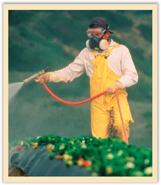17.2 Evolution as Genetic Change in Populations
 How does natural selection affect single-gene and polygenic traits?
How does natural selection affect single-gene and polygenic traits? What is genetic drift?
What is genetic drift? What conditions are required to maintain genetic equilibrium?
What conditions are required to maintain genetic equilibrium?
directional selection
stabilizing selection
disruptive selection
genetic drift
bottleneck effect
founder effect
genetic equilibrium
Hardy-Weinberg principle
sexual selection
Preview Visuals Before you read, look at Figure 17–6. What evolutionary trend does it seem to show?
THINK ABOUT IT Ever since humans began farming, they have battled insects that eat crops. Many farmers now use chemicals called pesticides to kill crop-destroying insects. When farmers first used modern pesticides such as DDT, the chemicals killed most insects. But after a few years, many pesticides stopped working. Today, farmers fight an ongoing “arms race” with insects. Scientists constantly search for new chemicals to control pests that old chemicals no longer control. How do insects fight back? By evolving.
At first, individual pesticides kill almost all insects exposed to them. But a few individual insects usually survive. Why? Because insect populations often contain enough genetic variation that a few individuals, just by chance, are resistant to a particular pesticide. By killing most of the susceptible individuals, farmers increase the relative fitness of the few individuals that can resist the poison. Those insects survive and reproduce, passing their resistance on to their offspring. After a few generations, the descendants of the original, resistant individuals dominate the population.
To understand completely how pesticide resistance develops, you need to know the relationship between natural selection and genetics.

How Natural Selection Works
 How does natural selection affect single-gene and polygenic traits?
How does natural selection affect single-gene and polygenic traits?
Pesticide-resistant insects have a kind of fitness that protects them from a harmful chemical. In genetic terms, what does fitness mean? Each time an organism reproduces, it passes copies of its genes on to its offspring. We can, therefore, view evolutionary fitness as success in passing genes to the next generation. In the same way, we can view an evolutionary adaptation as any genetically controlled trait that increases an individual's ability to pass along its alleles.

Table of Contents
- Formulas and Equations
- Applying Formulas and Equations
- Mean, Median, and Mode
- Estimation
- Using Measurements in Calculations
- Effects of Measurement Errors
- Accuracy
- Precision
- Comparing Accuracy and Precision
- Significant Figures
- Calculating With Significant Figures
- Scientific Notation
- Calculating With Scientific Notation
- Dimensional Analysis
- Applying Dimensional Analysis




